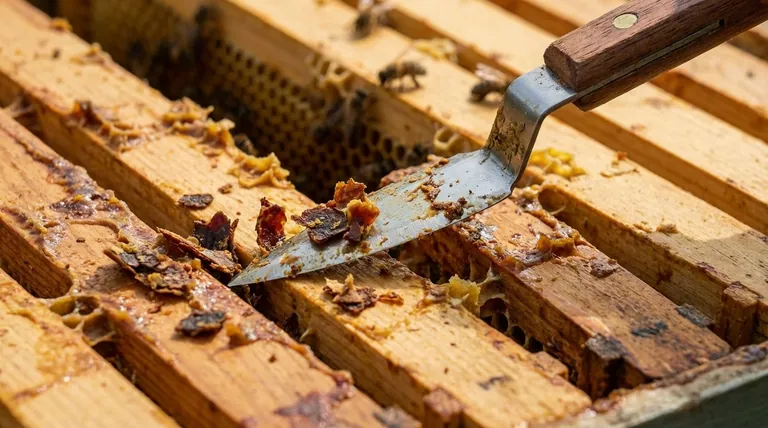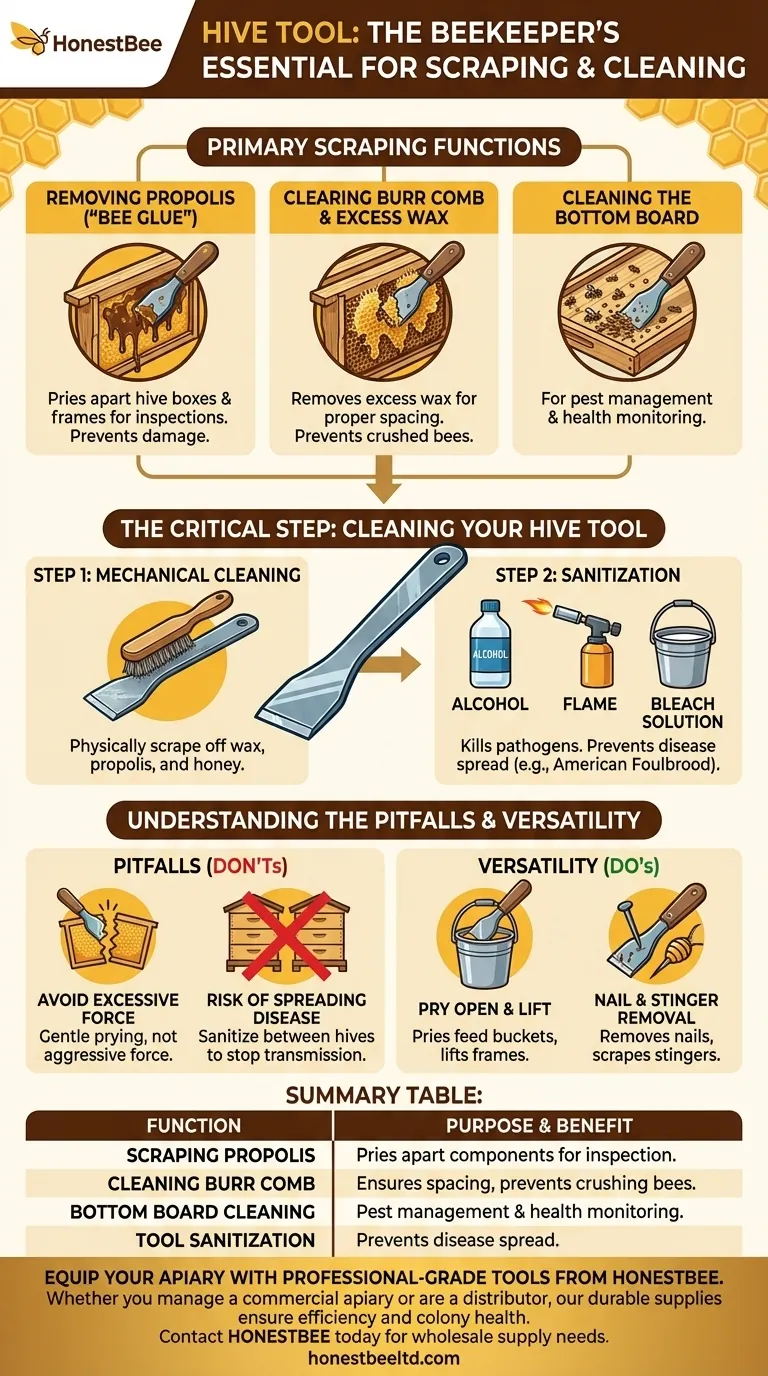At its core, a hive tool is the beekeeper's essential multi-tool for hive maintenance. Its primary scraping function involves using the flat, sharpened end to remove propolis (a sticky resin bees use as glue) and unwanted burr comb from frames and hive bodies. This cleaning action is not just for tidiness; it is critical for enabling hive inspections and maintaining a healthy, manageable colony.
A hive tool's scraping and cleaning functions are fundamentally about control. By methodically removing the propolis and wax that bees use to seal their environment, you ensure that you can access, inspect, and manage the hive's components without causing undue stress to the colony or damage to the equipment.

The Primary Scraping Functions
The most common use of a hive tool is to combat the bees' natural tendency to glue everything together. This involves precise scraping and prying to keep the hive components accessible.
Removing Propolis ("Bee Glue")
Propolis, or "bee glue," is a resinous mixture that honey bees produce to seal unwanted open spaces. While it has antimicrobial properties, it acts like a powerful adhesive.
Your tool is used to scrape propolis from the contact points between hive boxes (supers) and, most importantly, from the "ears" of the frames where they rest. A buildup here makes it nearly impossible to lift frames for inspection.
Clearing Burr Comb and Excess Wax
Bees will often build "burr comb" in any space that is not exact "bee space." This wild comb can be found between frames, on top of frames, and connecting the inner cover to the frames.
The flat edge of the hive tool is perfect for scraping this comb away. Removing it prevents you from crushing bees when you replace frames or boxes and ensures components fit together properly.
Cleaning the Hive's Bottom Board
The tool is also used to scrape debris, wax, and dead bees off the hive's bottom board. This is a critical task for hive hygiene.
Regularly cleaning the bottom board helps with pest management, as it removes potential hiding places for Small Hive Beetles and allows you to better monitor for varroa mite drop.
The Critical Step: Cleaning Your Hive Tool
A clean tool is essential for good beekeeping hygiene. Moving from one hive to another with a dirty tool can easily spread diseases throughout your apiary.
Step 1: Mechanical Cleaning
First, use the sharp edge of the tool itself or a stainless-steel scrubber to physically scrape off as much wax, propolis, and honey as possible. This is the essential first step before sanitizing.
Step 2: Sanitization
After scraping, you must sanitize the tool. There are several effective methods:
- Alcohol Immersion: Soaking the tool in rubbing alcohol (isopropyl alcohol) is a simple and effective way to kill pathogens.
- Flame Sterilization: Using a blow torch to heat the tool for around 30 seconds will incinerate any contaminants. You can also place it in the hot fire pot of your bee smoker.
- Bleach Solution: Scrubbing with a diluted bleach solution (like Comet cleanser) followed by a thorough rinse is another common practice.
Understanding the Pitfalls
While indispensable, improper use of a hive tool can cause problems. Understanding the risks is key to effective and gentle beekeeping.
Avoid Excessive Force
Remember that you are working with a living colony. Use the tool for gentle, steady prying and leverage, not for aggressive force. Jamming the tool or making sudden, jarring movements will agitate the bees and can damage the wooden hive components.
The Risk of Spreading Disease
Never move from a known sick hive to a healthy hive without thoroughly sterilizing your tool. It is the primary vector for transmitting devastating diseases like American Foulbrood. Many beekeepers keep separate tools for different apiaries or even carry a container of alcohol to dip their tool in between hive inspections.
Don't Overlook Its Versatility
Failing to use the tool for its many other functions can make your work harder. It is designed to pry open feed buckets, remove nails, lift frames, and even scrape away a bee stinger from your skin without injecting more venom.
Making the Right Choice for Your Goal
Your approach to using the hive tool will vary slightly depending on your immediate objective.
- If your primary focus is a routine inspection: Use the tool to gently pry the inner cover, then scrape the frame rests to ensure each frame can be lifted smoothly and easily.
- If your primary focus is deep hive cleaning or swarm prevention: Use the flat end to thoroughly scrape all burr comb from between boxes and clean the bottom board of all debris.
- If your primary focus is disease prevention: Meticulously clean and sanitize your tool between inspecting each hive, especially if you manage multiple apiaries.
Mastering this simple steel bar is a foundational step toward becoming a confident and proficient beekeeper.
Summary Table:
| Key Function | Purpose & Benefit |
|---|---|
| Scraping Propolis | Pries apart hive boxes and frames for inspections, preventing damage. |
| Cleaning Burr Comb | Removes excess wax to ensure proper frame spacing and prevent crushed bees. |
| Bottom Board Cleaning | Scrapes away debris for better pest management and colony health monitoring. |
| Tool Sanitization | Prevents the spread of diseases like American Foulbrood between hives. |
Equip your apiary with professional-grade tools from HONESTBEE.
Whether you manage a commercial apiary or are a beekeeping equipment distributor, the right tools are fundamental to efficiency and colony health. HONESTBEE supplies durable, reliable beekeeping supplies and equipment through our wholesale-focused operations, helping you maintain healthy, productive hives.
Contact HONESTBEE today to discuss your wholesale supply needs and elevate your beekeeping operations.
Visual Guide

Related Products
- HONESTBEE Premium Italian Style Hive Tool with Hardwood Handle
- Professional Multi-Function Stainless Steel Hive Tool
- HONESTBEE Professional Long Handled Hive Tool with Precision Cutting Blade
- HONESTBEE Advanced Ergonomic Stainless Steel Hive Tool for Beekeeping
- Professional Dual-End Stainless Steel Hive Tool for Beekeeping
People Also Ask
- Is it advisable to manage a large number of hives alone? The Risks of Solo Beekeeping at Scale
- What is required for regular inspections in both Flow Hives and Langstroth hives? Essential Beekeeping Tasks Explained
- What are some common uses of a hive tool? Essential Multi-Purpose Tool for Every Beekeeper
- What are the basic tools for beekeeping? Essential Starter Kit for Safe & Successful Hive Management
- How should beekeepers handle bees when using a hive tool? Master Calm, Deliberate Techniques



















